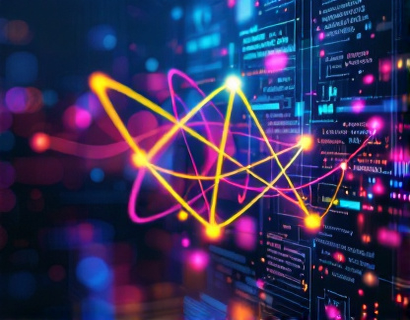Revolutionizing Ucosystem Engagement: The Synergy of AI and Crypto
The integration of artificial intelligence and cryptocurrency is ushering in a new era of digital interaction, one that promises to revolutionize how users engage with online platforms and services. This fusion of technologies is not just a novel concept but a transformative force that is redefining the landscape of digital experiences. By leveraging the strengths of both AI and crypto, a pioneering platform is emerging that enhances user engagement and unlocks unprecedented opportunities in the crypto and AI sectors.
The foundation of this revolution lies in the unique capabilities of artificial intelligence. AI's ability to process vast amounts of data, learn from patterns, and make intelligent decisions in real-time provides a robust framework for creating personalized and dynamic user experiences. In the context of the Ucosystem, AI can analyze user behavior, preferences, and interactions to tailor content and services that are highly relevant and engaging. This level of personalization is crucial in maintaining user interest and fostering long-term engagement.
Cryptocurrency, on the other hand, brings a decentralized and secure method of transaction and value exchange. The blockchain technology underlying crypto assets ensures transparency, immutability, and security, which are essential for building trust in digital interactions. When combined with AI, cryptocurrency can offer a seamless and secure way to monetize and reward user engagement, creating a symbiotic relationship between users and platforms.
Enhanced User Engagement through AI-Driven Personalization
One of the most significant impacts of AI in the Ucosystem is the ability to deliver highly personalized content and services. By analyzing user data, AI algorithms can identify patterns and preferences, allowing platforms to curate experiences that resonate with individual users. This personalization extends beyond simple recommendations; it encompasses everything from customized interfaces to tailored notifications and interactive elements.
For instance, an AI-powered news aggregator can filter and prioritize articles based on a user's reading history and interests, ensuring that the content is always relevant and engaging. Similarly, a gaming platform can adjust difficulty levels and suggest new games based on a player's skill and preferences, keeping users engaged for longer periods. This level of personalization not only enhances user satisfaction but also increases the likelihood of sustained interaction with the platform.
Secure and Transparent Transactions with Cryptocurrency
The integration of cryptocurrency into AI-driven platforms introduces a new dimension of security and transparency. Traditional online transactions often involve intermediaries such as banks and payment processors, which can introduce delays and vulnerabilities. Cryptocurrency transactions, facilitated by blockchain, are direct, fast, and secure. This reduces the risk of fraud and ensures that user data and transactions are protected.
Moreover, the use of cryptocurrency allows for micropayments, enabling platforms to monetize content and services on a granular level. This model incentivizes creators to produce high-quality content, knowing they can be compensated fairly for their work. For users, it means access to a wide range of premium services without the need for subscriptions or ads, enhancing the overall digital experience.
Decentralized Identity and Authentication
Another transformative aspect of combining AI and cryptocurrency is the concept of decentralized identity and authentication. Traditional online identities are often centralized and vulnerable to breaches. By leveraging blockchain and AI, users can create and manage their digital identities in a decentralized manner, giving them full control over their personal data.
AI can enhance this process by verifying identities through biometric data and behavioral patterns, ensuring that only authorized users access specific services. This not only improves security but also streamlines the login and authentication process, making it more user-friendly. Users can seamlessly switch between platforms and services without the hassle of multiple passwords and verification steps.
Tokenized Rewards and Incentives
The tokenization of rewards and incentives is a game-changer in user engagement strategies. By issuing unique tokens that represent value within a platform's ecosystem, AI-driven services can motivate users to participate actively. These tokens can be earned through various activities such as content creation, sharing, and engagement, and can be used to access premium features or traded within the ecosystem.
AI algorithms can dynamically adjust the reward mechanisms based on user behavior and platform goals, ensuring that incentives remain relevant and effective. For example, a social media platform could use AI to identify influential users and reward them with tokens for creating high-quality content, which in turn encourages others to contribute valuable content as well.
Predictive Analytics and User Insights
AI's predictive analytics capabilities provide deep insights into user behavior and trends, enabling platforms to make data-driven decisions. By analyzing large datasets, AI can forecast user actions, identify potential churn, and suggest proactive measures to retain users. This foresight allows platforms to enhance user retention and satisfaction, creating a more robust and engaged community.
For instance, an AI-driven e-learning platform can predict which courses a user is likely to complete based on their past behavior and suggest personalized learning paths. This not only improves the user experience but also increases the platform's value proposition, attracting more users and keeping them engaged over time.
Fraud Detection and Risk Management
The combination of AI and cryptocurrency also significantly enhances fraud detection and risk management. AI algorithms can monitor transactions and user activities in real-time, identifying suspicious patterns and anomalies that may indicate fraudulent behavior. This proactive approach to security helps protect both the platform and its users from potential threats.
In the context of cryptocurrency, where transactions are pseudonymous, AI can cross-reference data from multiple sources to build a comprehensive view of user behavior. This helps in detecting and preventing activities such as money laundering and identity theft, ensuring a safe and trustworthy environment for all users.
Community Governance and Decentralized Decision-Making
The decentralized nature of cryptocurrency aligns well with the principles of community governance in AI-driven platforms. By using blockchain-based voting systems and smart contracts, platforms can involve users in decision-making processes, ensuring that the direction of the platform reflects the collective will of its community.
AI can facilitate this process by analyzing user preferences and suggestions, identifying consensus points, and proposing actionable decisions. This democratic approach not only increases user engagement but also fosters a sense of ownership and loyalty among the community members.
Future Prospects and Challenges
As the integration of AI and cryptocurrency continues to evolve, the potential for innovation in the Ucosystem is vast. However, this journey is not without challenges. Regulatory uncertainties, technical complexities, and user adoption rates are key factors that need to be addressed to fully realize the transformative potential of this fusion.
Regulators will need to develop frameworks that balance innovation with consumer protection, ensuring that the benefits of AI and cryptocurrency are harnessed without compromising security and fairness. Technically, interoperability between different blockchain networks and AI systems remains a challenge that requires collaborative efforts from developers and industry stakeholders.
User education and awareness are also crucial. As these technologies become more prevalent, it is essential to empower users with the knowledge to navigate and benefit from AI and cryptocurrency-driven platforms. By addressing these challenges, the Ucosystem can continue to thrive, offering enhanced digital experiences that redefine online interaction and connectivity.
In conclusion, the convergence of AI and cryptocurrency is paving the way for a new era of digital engagement. By leveraging the strengths of both technologies, platforms can create personalized, secure, and rewarding experiences that keep users engaged and motivated. As this field continues to evolve, the possibilities for innovation and growth are endless, promising a future where digital interactions are more meaningful and impactful than ever before.










































